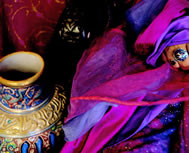




 |
    |
Reviews |
||
|
|
Shusha GuppyThe encounter with the Middle East has fired the imagination of Western artists for centuries. From Ingres to Delacroix, from Jérome to Matisse, the engagement with the Eastern 'Other' has produced art of enduring beauty. But the strands that converge to weave the rich texture in Carolinda Tolstoy's faïence have more varied sources. From her ancestral Greece come her love of form and Apollonian light and her facility with abstract motives and bright colours. More recently she has drawn inspiration from Persian Miniature, from its emergence in Persia during the Timurid period to its apogee in the Safavid era and the school of Isfahan (15-17C). Islam's prohibition against representational art compelled artists in Muslim societies to find expression in new, abstract forms. It led to the flowering of arts and crafts throughout the Islamic world and produced monuments of unique richness and variety. Without it we would not have the Alhambra, the Safavid Shah (Imam) Mosque in Isfahan, the masterpieces of Islamic calligraphy, the infinity of decorative motives in textiles, ceramics and metal-work. Persian Miniature, devised to break artistic constraints, found justification in the illustration of sacred texts and the poetry of great mystic poets, thus securing the protection and patronage of the Shah. Behzad, the greatest master of the art of miniature, became a protégé of Shah Ismail Safavid who appointed him to head his Kitabkhaneh (library). From then on the art of miniature painting flourished, and spread all over the Islamic world, particularly in Mogul India. Together with the poetry it often accompanies. Classical Persian miniature is the expression par excellence of the irrepressible genius of Persia. Carolinda Tolstoy adapts characters and motives from Persian miniatures - the idealised Beloved, the solitary Lover, the paradisic bird - to her own original vases, bowls, plates and decorative objects. Her soft, curvaceous arabesques, the opaline translucence of her colours, her delicate use of gold lines, reminiscent of Persian faïence, are a means to an end - the expression of her own feminine sensibility. It is the blend of artistic vigour with emotional commitment and romantic passion that make Carolinda Tolstoy's work so compelling. How such a petite, delicate woman can have so much energy and produce such a consistent body of work is part of the mystery of art. © Shusha Guppy
|
 |
| © Carolinda Tolstoy 1999-2018 | Web site design: QuincDigital |